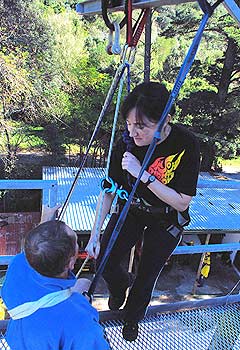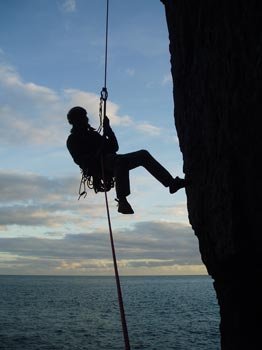And then you take a step backwards.
But instead of a rapid, unchecked descent (otherwise known as hurtling to your death), you control how fast you drop into the void.
Abseiling allows you ample time to examine the pores on an unassailable rock face, look black eagles in the eye, taste untainted air, and become re-acquainted, in slo-mo, with one of the few truly innate human fears: Falling.
By the time your feet regain solid ground that Fear has transmuted into Exhilaration and you're ready, like a kid on a rollercoaster, to do it all over again. You're hooked.
Rope tricks
Abseiling (or rappelling) originated and is used primarily in mountaineering, but it's also employed by the military, firefighters, window-washers and other action heroes.
The applications are wide-ranging: people zip down overhangs and glaciers and skyscrapers, off bridges, out of helicopters, into the maws of caves and between laser sensors to snatch priceless artifacts and microchips.
Or, as I did recently, they tackle the abseil tower at Newlands Fire Base in Cape Town - not all that high at 15m, but quite high enough. The fear factor is further upped by the lack of comforting rock bulk to brace yourself against, and by the Tower's tendency to sway and creak like the mast of a 16th-century schooner.
The simple, elegant "rope trick", which allowed me to lower my full body weight, in a secure and orderly fashion, back down to the friendly Newlands Forest soil below using no effort greater than a modest braking action with one hand, can only really be properly demonstrated in the real world. But this pic gives an inkling of what to expect:
The abseil rope (white) is looped through an anchor point above me, and through a "descender" device (this one's called a figure-of-8) attached to my climbing harness. I control my downward movement by playing the abseil rope out and braking with my right hand. I'm also on a belay/safety rope (where I've got my left hand), which the belayer would use to catch me should I let go with my braking hand.
Handy hints for gauche new abseilers
As I stepped off the Tower into space, the instructor (Rob Erasmus, Volunteer Wildfire Services' General Manager) said what sounded like: "Careful not to hit your head on the helicopter," as if things weren't surreal enough already.
The point he was making is that you don't just hang there like a sack of potatoes and risk clocking yourself on the helicopter (for example) as you leave it; you brace your free hand against the side to prevent this. And unwise though it may feel, to prevent more twisting and banging into things you should also lean back into the drop and "sit" in the harness. When abseiling down something with more substance, like a rock face or the Ponte building, you "walk" your feet down the vertical surface in front of you.
Another nicety of abseil deportment: the only item you should hold onto at all costs is the rope in your braking hand. This at first feels counterintuitive and you'll be tempted to cling instead onto other things like the instructor and the rope above you, but this is an undignified and largely ineffective course of action for preventing your downward motion.
Fear of falling is inscribed into our DNA, and a very sensible adaptation it is too. Your forebears passed down through the aeons the genome you carry today, and one of the reasons it reached you intact is because they weren't among those Homo erectus fools who thought it amusing to freak out the rest of the tribe by larking around on the cliff-edge.
But while fear is healthy and useful, unseemly panic is not. Once you've taken the plunge and carefully chosen your abseil instructor, you're going to have to trust him/her, and let go. Just not with your braking hand.
So where's the sweat?
Abseiling per se is not particularly physically taxing, but its natural companion activities, like hiking and climbing to get up something in order to come down it again, are easy enough to incorporate. You can also get a climbing instructor to teach you various strenuous techniques for ascending the rope itself, if you feel you need more punishment.
But abseiling's "workout" is primarily psychological. Facing down one of the great primal fears is always good for boosting the old self-confidence and sense of control, and there's nothing like an adrenalin spike to get your mind engaged in the moment instead of its other humdrum worries. The abseil process lets you feel that you're working with the law of gravity for an outcome that suits you for a change, rather than being weighed down by it.
Abseiling at Swanage, Dorset, UK
(Photo: Jeremy Colenso)
Mountain abseiling: no second chances
World class mountaineer Rachel Colenso has been known to add drama to her public speaking engagements by abseiling onto the stage. "It certainly gets the audience's attention if you drop down from the ceiling. And it helps keep them captivated if you start your speech while you're still dangling there!"
But Rachel makes a clear distinction between abseiling under controlled conditions (crowd-pleasing stunts such as this or recreational abseiling with a safety line) and abseiling in a wilderness environment where there are multiple risk factors to contend with.
"Most fatal mountaineering accidents happen on the way down from a climb, and the majority of these are while abseiling," says Rachel, who has lost two close friends this way. One, a "truly gifted" young climber, died aged 23 abseiling off an ice-fall in Canada; the other fell on Mount Kenya when he dislodged a boulder while attempting to free a jammed abseil rope.
"So you don't abseil down a summit unless there's no other way down. If you can walk down you walk – even if it takes a bit longer."
With free climbing, explains Rachel, the protective gear is there only to catch you if you make a mistake, but with abseiling your life depends on it entirely.
"Abseiling is risky because you're putting your trust 100% in your equipment, and in placing and using it correctly. Also, after a climb you're fatigued and it's easy to lose concentration – especially during multiple abseils (it can take 15 or 20 to get down a mountain). And you might be time pressured – if there's an impending storm, for example."
"Even experienced climbers sometimes do silly things, like abseiling in tandem down either side of a rope to get down quicker, or running out of rope."
The obvious take-home message being: inexperienced climbers/abseilers are likely to do even sillier things, and probably not just sometimes. So put in plenty of time practising "controlled" abseiling before you attempt anything more ambitious.
Rachel abseiling in Yosemite.
(Photo: Jeremy Colenso)
Useful contacts for safely learning the ropes
Abseiling is fun, but it's only as safe as the person running the show – and that should be someone for whom this kind of ropework is second nature, and who is known and respected by other veterans. Don't just pick the first commercial adventure enterprise on Google that looks like they sort of know what they're up to: do a background check.
- The Mountain Club of South Africa (MCSA) has branches throughout the country. They can advise as to whether a commercial abseiling company is reputable and can also put you in touch with MCSA members who teach abseiling and climbing.
MCSA Cape Town office Tel: 021 465 3412 (10:00-14:00)
Jhb Office Tel: 011 807 1310 (8-10am)
E-mail: info@mcsa.org.za
- Rachel Colenso and husband Jeremy, also a top mountaineer, offer climbing instruction and guiding, and can recommend other reputable instructors.
Contact Rachel (based in Cape Town): Tel 072 263 6029 E-mail rachel@kelseyadventures.co.uk. Read about Rachel's latest expedition
- If you're in Cape Town on 29 November, you can brave the Newlands Abseil Tower yourself under the supervision of seasoned firefighters at the Volunteer Wildfire Services' Open Day. See www.capefires.com for more info.
- Olivia Rose-Innes, Health24, November 2008




 Publications
Publications
 Partners
Partners












